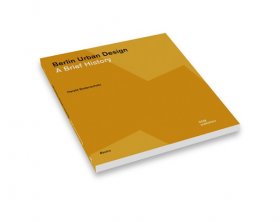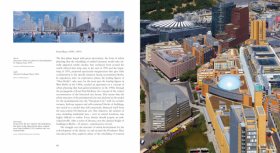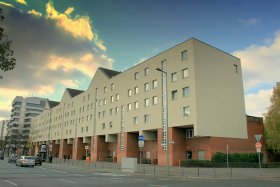Architecture Berlin
 Short notice, but I’ll be giving a short talk tomorrow with Prof. Harald Bodenschatz at the TU, as part of an event for the launch of the Berlin Urban Design book (see earlier post).
Short notice, but I’ll be giving a short talk tomorrow with Prof. Harald Bodenschatz at the TU, as part of an event for the launch of the Berlin Urban Design book (see earlier post).
I’ll stick to the point, and they’ll be slides! All details below:
Der Hinterhof in Berlin
Brennpunkt des Berliner Städtebaus
Abendveranstaltung
anlässlich des Erscheinens der zweiten, erweiterten Auflage von
* Städtebau in Berlin. Schreckbild und Vorbild für Europa
* Berlin Urban Design. A Brief History of a European City
Verlag DOM publishers
In der städtebaulichen Debatte fungierte der Hinterhof über Jahrzehnte als schlimmste Verkörperung unmenschlichen Wohnens, als finsterer steinerner Ort ohne jede Nutzungsqualität, als Hölle für aufwachsende Kinder, als Mahnmal der nicht erhaltenswerten, ja unbedingt zu beseitigenden Mietkasernenstadt. Heute ist der Hinterhof wieder rehabilitiert, als ruhiger, oft grüner Raum, dessen Struktur bei Neubauten sogar eine Wiederauferstehung feiert. Kein städtebauliches Element wurde in der jüngeren Städtebaugeschichte dermaßen verteufelt wie der Berliner Hinterhof, und kein städtebauliches Element hat ein solch atemberaubendes Comeback erlebt wie eben jener Hinterhof.
 Begrüßung und Moderation
Begrüßung und Moderation
Prof. Dr. Cordelia Polinna, TU Berlin
Von der Hölle zur Idylle
Zur Karriere des Berliner Hinterhofes
Prof. Dr. Harald Bodenschatz, TU Berlin
Comment: An English Perspective on Berlin
Jim Hudson, , Co-Übersetzer der zweiten englischen Auflage
Das Berlinbuch: Start der Reihe „Grundlagen“
Natascha Meuser, Verlag DOM publishers
Eine Veranstaltung des FG Planungs- und Architektursoziologie der TU Berlin
in Kooperation mit dem Verlag DOM publishers

While nothing is sacred, it’s depressing when something thoughtless like this happens, especially as it’s essentially replacing much needed social housing with private luxury development (if anything actually gets built at all).
A spot of self-publicity in a way, as the 2nd, revamped edition of Berlin Urban Design, by Harald Bodenschatz, has been published recently, English translation by me*.
I notice that amazon.co.uk has the old, out-of-date edition, so check carefully before you buy. The new (2nd) edition has additional and extended chapters, bringing the narrative up to date with various current projects, including the building of the glorious new BER airport, due to open in 2012. 2013. 2014 the 21st century**.
I reviewed the original edition on this blog about three years ago, commenting that it was a good book with a poor English translation. As a consequence, I was given the chance to have a go myself, including some updated and additional chapters. Hope you like it.
The book is a short but oh-so-informative history of Berlin’s urban development, cantering quickly through its medieval roots to focus on the city’s colossal 19th century expansion, 20th century utopianism, and post-wall euphoria-to-debt story, with much more along the way. Maps and images are fantastic, text is not too shabby either.
Will bring some copies along to Wednesday’s book club.
* The intro was written in English by Karl Friedhelm Fischer. Original translation of 1st edition by Sasha Disko.
** See press for details. Mayoral careers can go down as well as up.
Italo Calvino’s Invisible Cities is a series of descriptions, really conversations, told by a fictitious Marco Polo to an invented Kublai Khan. As Marco travels round the world on the Emperor’s business, his job is not to bring back treasure or trade, but to barter in stories – the accumulated wealth of his imagination.
Here are all the cities ever dreamed of; thin cities, cities and desire, cities and the dead, cities and memory, continuous cites, cities and signs. All are named after women – Raissa, Irene, Phyillis, Chloe… ‘In Chloe, a great city, the people who move through the street are all strangers. At each encounter they imagine a thousand things about one another; meetings which could take place between them, conversations, surprises, caresses, bites. But no-one greets anyone; eyes lock for a second, then dart away, seeking other eyes, never stopping.’
Calvino was writing about Venice – all the Venice’s collapsed, folded or vanished behind the tourist façade. Anyone who loves Venice, knows that its true life is half-glimpsed or dreamed, that the city reconfigures itself, yielding suddenly as you turn into a deserted square, snapping shut, as you walk past San Marco.






